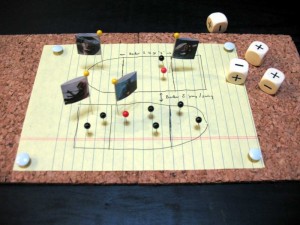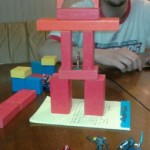Sweet Ride
It’s been a while since I’ve sat down and put together a blargpost. As it is gaming has been fairly routine for me lately. Not that that’s bad, but it means there’s not a whole lot that jumps out and says “Hey, write about me!” But our last few RPG sessions saw an interesting reaction between players, GM, and props.
Our current game is a Sci-Fi setting using the Savage Worlds ruleset and have been using some of his son’s Lego Minifigs as miniatures when we play. A few sessions ago we were given a task to perform and hummer-esque vehicle to take to our destination. We initially started with a couple large flat Lego pieces to represent the vehicle but our nerdiness couldn’t let the abstract stand. So while we played, a couple of us started putting together a vehicles with whatever pieces were in the box of Legos near the table. Thus, the “Sweet Ride” was born. And no, before you ask, you’re never to old for Legos. Ever.

